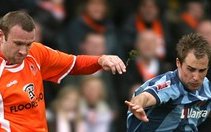SeasideEssexXile tells us all we need to know about Craven Cottage ahead of Sunday’s game.
Craven Cottage – Fulham
By SeasideEssexXile
One week since the Thames` big event of the year – the Varsity Boat race has rowed on past, and now the Pool pull up along the leafy banks to scupper Fulham`s attempt to escape the relegation battle. It won`t be easy, Fulham have had a good turn of form at home since the New Year and it`s been December since we returned with 3 points from our travels. There`s only 3 away games left, 2 in London and the other in the season finale at Old Trafford, out of these 3 this, on paper, provides the best chance of bringing home the spoils.
The Ground
The original ‘Cottage’ was built in 1780, by William Craven, the sixth Baron Craven and was located on the centre circle of the pitch. At the time, the surrounding areas were woods which made up part of Anne Boleyn’s hunting grounds. Several other sports are presumed to have taken place here besides hunting. As well as more lethargic games such as lawn bowls and croquet, a version of the Aztec game called ‘tlachtli’ (scoring a ball through a hoop using your hips) is alleged to have been played here. This game is thought to be a distant cousin of association football and is arguably one of the earliest codes of organised football.
It was lived in by Edward Bulwer-Lytton (who wrote The Last Days of Pompeii) and other somewhat notable (and moneyed) persons until it was destroyed by fire in May 1888. Many rumours persist between Fulham fans of past tenants of Craven Cottage. Sir Arthur Conan Doyle, Jeremy Bentham, Florence Nightingale and even Queen Victoria are assumed to have stayed there, though these are all likely to have been fabricated. Following the fire, the site was abandoned. Fulham had had 8 previous grounds before settling in at Craven Cottage for good. Therefore, The Cottagers have had 10 grounds overall (if including Loftus Road) meaning only their ‘landlords’ and rival QPR has had more home grounds (14) in British football.
When representatives of Fulham first came across the land, in 1894, it was so overgrown that it took two years to be made suitable for football to be played on it. A deal had been done that meant this work was done by the owners of the ground, who then would receive a proportion of the gate receipts.
The first event at which there were any gate receipts was when Fulham played against Minerva in the Middlesex Senior Cup, on 10 October 1886. The ground’s first stand was built shortly after. Described as looking like an ‘orange box’, it consisted of four wooden structures each holding some 250 seats, and later was affectionately nicknamed the ‘Rabbit hutch’.
Before the ground could become too well established, the now defunct London County Council became concerned with the level of safety at the ground, and tried to get it closed. A court case followed in January 1905, as a result of which Archibald Leitch, a Scottish architect who had risen to prominence after his building of Ibrox a few years prior, was hired to work on the stadium. In a scheme costing £15,000 (a record for the time), he had a new pavilion (the modern Cottage itself) and a stand built, in his characteristic red brick style.
The stand on Stevenage Road celebrated its centenary in the 2005-2006 season and, following the death of Fulham FC’s favourite son, former England captain Johnny Haynes, in a car accident in October 2005 the Stevenage Road Stand was renamed the Johnny Haynes Stand after the club sought the opinions of Fulham supporters.
Both the Johnny Haynes Stand and Cottage remain among the finest examples of Archibald Leitch football architecture to remain in existence and this has been recognised with both being designated as Grade II listed buildings.
An England v Wales match was played at the ground in 1911, followed by a rugby league international between England and Australia.
One of the club’s directors Henry Norris, and his friend William Hill, took over Arsenal in the early 1910s, the plan being to merge them with Fulham, to form a ‘London superclub’ at Craven Cottage. This move was largely motivated by Fulham’s failure thus far to gain promotion to the top division of English football. There were also plans for Henry Norris to build a larger stadium on the other side of Stevenage Road but there was little need after the failed merger.
The ground again suffered a scare in 1933, when there were plans to demolish it and start again from scratch with a new ground, to have a huge capacity of 80,000. These plans never materialised mainly due to the Great Depression.
On 8 October 1938, Craven Cottage held host to 49,335 fans during a game against Millwall. The ground hosted several football games for the 1948 Summer Olympics
It wasn’t until Fulham first reached the top division, in 1949, that further improvements were made to the stadium. The first was that the next year they became the final side in the division to erect floodlights. The floodlights were said to be the most expensive in Europe at the time as they were so modern. The lights were like large pylons towering 50 metres over the ground and were similar in appearance to those at the WACA. The Hammersmith end had a roof put over it, and an electronic scoreboard was put up.
After Fulham was relegated, the development continued. The Riverside terracing, infamous for the fact that fans occupying it would turn their heads annually to watch The Boat Race pass, was replaced by what was officially named the ‘Eric Miller stand’, Eric Miller being a director of the club at the time. The stand, which cost 334,000 pounds and held 4,200 seats, was opened with a friendly game against Benfica in February 1972, (which included Eusebio). Miller committed suicide five years later after a political and financial scandal that he was involved in boiled over. The stand is now better known as the Riverside Stand. The Riverside bank also was unique for the fact that flags of all the other teams of the first division were flown along the promenade. Boxing 1963, Craven Cottage was the venue of the fastest hat-trick in the history of the English football league, which was completed in less than three minutes, by Graham Leggat. This helped his Fulham team to beat Ipswich 10-1 (a club record). Between 1980 and 1984, Fulham rugby league played their home games at the Cottage. They have since evolved into the London Crusaders, the London Broncos, and then into Harlequins Rugby League. Craven Cottage held the team’s largest ever crowd at any ground was 15,013, at a game against Wakefield Trinity on 15 February 1981.
Following the Taylor report Fulham’s chairman Jimmy Hill tabled plans for an all-seater stadium. These plans never came to fruition, partly due to local residents’ pressure groups, and by the time Fulham reached the Premiership, they still had standing areas in the ground, something virtually unheard of at the time. Fulham moved to Loftus Road, home of local rivals QPR. During this time, many Fulham fans only went to away games in protest of moving from Craven Cottage. ‘Back to the Cottage’, later to become the ‘Fulham Supporters Trust’, was set up as a fans pressure group to encourage the chairman and his advisers that Craven Cottage was the only viable option for Fulham Football Club.
After one and a half seasons at Loftus Road, no work had been done on the Cottage. In December 2003, plans were unveiled for £8million worth of major refurbishment work to bring it in line with Premier League requirements. With planning permission granted, work began in January 2004 in order to meet the deadline of the new season. The work proceeded as scheduled and the club were able to return to their home for the start of the 2004-05 season. Their first game in the new-look 22,000 all-seater stadium was a pre-season friendly against Watford on July 10, 2004.
Current capacity is 25700, Fulham host a ‘neutral area`. Craven Cottage has been configured to allow the number of seats provided to the away club to vary between the minimum League requirement and up to a maximum of nearly 6,500. This has proved to be a huge advantage over the last couple of seasons when the Club was selling games with a large demand from the visiting club and a lesser demand from home fans (e.g. Cup ties against lower League opposition) as the Club is obligated to remove tickets from general sale when the away allocation and neutral areas sell out.
Tickets within the ‘neutral` area of the Putney Stand are sold on the premise that the individual could be sat next to a supporter of either team, or indeed a genuine neutral. The neutral area effectively acts as a buffer zone, allowing the Club to continue to sell tickets once the away allocation has sold out. The introduction of the neutral zone has been warmly received by all fans and has reduced the occurrence of away fans securing seats in home areas of the stadium over the last two seasons.
How To Get There
M55, M6 South. M1 then:
From the North: Take the A1/M1 to North Circular A406 follow signs for Harlesden A404, then take the A219 to Hammersmith. When on Broadway follow signs for Fulham, turn right after 1 mile into Harbord Street then left at the end for the ground.
If you take the M4:
From the West: Take the M4 to the A4. After two miles branch left into Hammersmith Broadway, then follow signs for Fulham. Turn right after 1 mile into Harbord Street then left at the end for the ground.
From the South/East: Take the South circular A205, follow signs for Putney Bridge A219, cross the bridge and follow signs for Hammersmith for half a mile. Take a left into Bishops Park Road, then right at the end.
Sat navvers – SW6 6HH
For The Virgin Lovers Amongst Us: By tube: Putney Bridge on the District Line is a 10 minute walk away.
For those flying Samm Airways Heathrow will be the nearest option.
Where To Drink
Friendly Fulham means take your pick of ale houses. Fulham High Street’s Zulus Bar and O`Neill`s are options as is the Eight Bells at Putney Bridge. The Crabtree on Rainvilled Road is another option.
Ale is on sale within the ground.
Plod & Stewards
It`s the Met – enough said. Stewards are reported as being ‘helpful`.
Fear Factor Rating – 1.
Aprils` huge, it all boils down to this month, we`ve played exciting, sometimes naive football and worthy of survival, but football can be a cruel game. It`s a strange league and the unveiling of a Michael Jackson statue at Craven Cottage on Sunday sets the prelude for what should be a thriller of a game. Here`s hoping that come half past 3 it the Pool who are singing, “easy as 1,2 3”.
Onwards + Upwards



